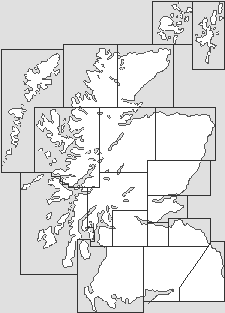 St Giles' Cathedral, Edinburgh |
Jenny Geddes lived from about 1600 to about 1660. She was an Edinburgh street-seller who famously, or infamously, threw her stool at the head of the Dean in St Giles' Cathedral in Edinburgh on Sunday 23 July 1637, and sparked a riot that led directly to the Wars of the Covenant; the Wars of the Three Kingdoms; the English Civil War; the execution of Charles I; and Cromwell's occupation of Scotland: 23 years of wide-ranging conflict that did not really end until the restoration of Charles II in 1660. The wider picture in Scotland at the time is set out in our Historical Timeline.
The origins of the 23 July 1637 riot date back to the accession to the throne of King Charles I in 1625. Here was a man who knew next to nothing about kingship beyond the fact that it came, he believed, with a divine right to rule issued directly by God. When he finally got round to holding a Scottish coronation in 1633 he held it in St Giles' Cathedral, but used the full Anglican rites in a service led by William Laud, his new Archbishop of Canterbury.
Since the Reformation of 1560 in Scotland, the Church of Scotland had evolved into a much more puritan creature than the Church of England. Charles I's coronation caused great disquiet in Scotland, threatening, in many people's eyes, to overturn everything the Reformation stood for and reintroduce a form of worship that they saw as little different to that used by the Catholic Church.
Undaunted, King Charles I assembled a commission whose remit was to produce a prayer book suitable for Scotland that would bring it much more into line with the Church of England. In 1637 a new Book of Common Prayer was printed in Edinburgh, and it was first used in St Giles' Cathedral on Sunday 23 July 1637.
Almost nothing is known about Jenny Geddes (even, for certain, whether she ever really existed at all), but there is a memorial to her in the cathedral. It is generally assumed that at the start of the service she was occupying a stool in the body of the kirk. She was probably one of the "waiting-women" who were paid to arrive early and sit on their stools to hold a place for their patrons. When John Hanna, Dean of Edinburgh, began to read the Collects, part of the newly prescribed service, Jenny Geddes threw her stool at his head, shouting: "Deil colic the wame o’ ye, fause thief; daur ye say Mass in my lug?" which can be translated as: "Devil cause you colic, false thief: dare you say the Mass in my ear?"
A full scale riot followed. The service continued after the rioters had been ejected from the cathedral, but to the accompaniment of the sound of the mob hammering on its doors and throwing stones at the windows. The rioting then spread across Edinburgh and to other Scottish cities. The Scottish Lord Advocate appointed a committee to negotiate with the Privy Council in London for the withdrawal of the Anglican liturgy from Scotland. Charles I refused to compromise. On 28 February 1638 the Scots responded by producing the National Covenant which was eventually to be signed by many thousands north of the border. This sought to preserve distinctive Scottish cultural and religious freedoms and practices.
In May 1639 Charles' response to what he considered a rebellion was to launch the First Bishops' War, the first of the Wars of the Covenant, against Scotland. This placed financial stress on his administration, and to raise new taxes he needed to recall the English Parliament, which started the process that led to the English Civil War; to his own execution; and to Cromwell's occupation of Scotland...
As an aside, there was another Jenny Geddes. It was the name that Robert Burns gave to the horse he had bought in Edinburgh for "over £4 Sterling" and which was to prove a faithful companion on his travels around Scotland.

